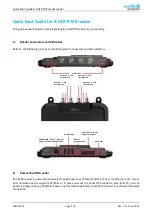
English (GB)
25
11. Fault finding
Warning
Before carrying out any work on lifting stations used for pumping liquids which might be hazardous to health, make sure that
the lifting station has been thoroughly flushed with clean water and that the discharge pipe has been drained. Rinse the parts
in water after dismantling. Make sure that the isolating valves have been closed. The work must be carried out in accordance
with local regulations.
Before making any connections in the LC 221 or work on lifting stations, etc., it must be ensured that the power supply has
been switched off and that it cannot be accidentally switched on.
Fault
Cause
Remedy
1. The pump(s)
does/do not run.
a) No power supply.
None of the indicator lights are on.
With battery back-up:
See section
Switch on the power supply or wait until the power cut
is over. During the power cut, drain the collecting tank
with diaphragm pump.
b) The ON-OFF-AUTO selector switch is in position
OFF ( ), see section
.
Push the ON-OFF-AUTO selector switch into position
ON ( ) or AUTO ( ).
c) Control circuit fuses are blown.
Check and eliminate the cause. Replace the control
circuit fuses.
d) The motor-protective circuit breaker has cut out
the pump (only relevant if a motor-protective
circuit breaker has been installed). The pump
symbol in the display is flashing and the red
indicator light for fault is flashing. The fault
indication in the display is RELAY and the fault
code is F018.
Check the pump and tank as well as the setting of the
motor-protective circuit breaker. If the pump is
blocked, remove the blockage. If the setting of the
motor-protective circuit breaker is wrong, readjust it
(compare the setting with the nameplate).
e) Motor/supply cable is defective or the connections
have become loose.
Check motor and supply cable. Replace cable or
retighten connections if necessary.
f)
The fault indication in the display is SENSOR and
in the fault code is F005 and/or F006.
Clean the level sensor (see section
), and start up again. Check the cable and
the connection on the controller board. If the signal is
still wrong, please call Grundfos service.
g) The module power circuit board or the LCD board
is defective.
Replace the PCB or LCD board.
2. The sensor signal is
out of range.
All pumps are
started and high
level alarm is on.
a) Discharge valves are not all opened.
Open all discharge isolating valves.
b) There is a blockage in the tank or pump.
Remove blockage.
c) The pump venting is not working, which means
that the pump cannot built pressure.
Remove blockage from the pump venting hole,
located above the impeller.
d) The lifting station is undersized.
Recalculate the inflow parameters and compare with
the size and pumping volume of the lifting station.
Contact the nearest Grundfos sales company for
ordering a new product if needed.
3. The pump(s) is/are
starting/stopping
too frequently and
even if there is no
inflow.
a) The level sensor fails. The sensor gives wrong
signal.
Clean the level sensor
(see section
10.4 Cleaning the level sensor
).
b) The operating time protection is activated, the
pump and time symbols are flashing, the red LED
is flashing and the display indicates fault code
F011 and/or F012. If the pump runs longer than 3
minutes, a protection program of the controller will
stop the pump for 3 minutes and the other pump
will take over. At the next start impulse, the first
pump will be activated again. If the venting
problem persists, the pump will be stopped after 3
minutes and so on.
Note:
Normal operating times are up to
60 seconds depending on duty point and effective
tank volume.
Check that the discharge valve is open. Check the
venting of the pump housing. If blocked clean the vent
hole. See fig.
.
c) The thermal switch has cut out the pump. The
pump and thermal switch symbols on the display
are flashing, and the red indicator light for fault is
permanently on. The fault indication in the display
is TEMP and in the fault code is F005 and/or
F006.
Allow the pump to cool. After cooling, the pump will
restart automatically unless the LC 221 has been set
to manual restarting. See section
. If so, the ON-OFF-AUTO selector switch must be
pushed into position OFF ( ) for a short period.
Check the inflow parameters and the non-return valve.
The risk is low, but if the non-return valve flap is leaky,
liquid in the discharge pipe can flow back.
A high number of starts without cooling time in
between over a longer period can cause thermal
cut-out. Consider S3 duty. See section
See also section
10.4 Cleaning the level sensor
4. One pump starts
sometimes without
visible reason.
a) Test run 24 hours after last operation.
No action necessary. It is a safety function that
prevents the shaft sealing from seizing up.






































